#capitalism with chinese characteristics
Photo









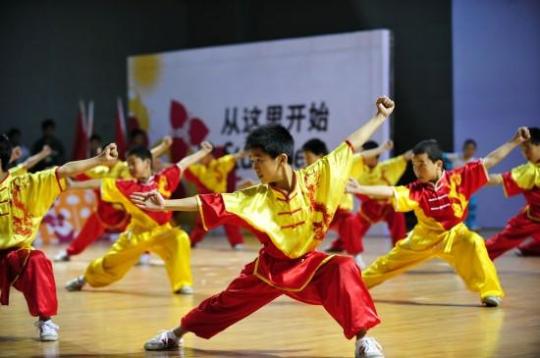
Apart From GDP As The Benchmark Of Success, China Is Bringing On Board A Number Of Fundamental Cultural & Education Reforms To Invest In The Next Generation
What are the impacts of globalization? Among others, globalization becomes evidently the process by which regional cultural influences affect one another. Different cultures result in being either more alike or increasingly tensional.
Asians believe that good relationship with a society comes from the respect of and obedience to leaders. Westerners contend that peaceful co-existence is conditional upon the compromise of the free wills and self-determinations of all individuals. The former stress that the young are to be enjoined and mistakes are to be avoided. The latter coach that life is a battle between a good and a bad wolf and we must learn to fight, with ourselves or others.
Countries nowadays still speak a totally different language: collectivism versus individualism, utilitarianism versus libertarianism, socialism versus capitalism, spirituality versus materialism, paternalistic versus emancipatory government; and muscular versus feminine society.
A wise person should not simply accept or reject. We must allow the occurrence of something that we may dislike or doubt; and patiently wait until the outcome proves the truth. What ways can produce a stronger country and happier people? Some countries tend to interfere other nations, for an ulterior purpose.
During the past 200 years, China, the 'Sleeping Dragon', went through too many sufferings: colonialism in Ching Dynasty, division by warlords(軍閥割據), Second World War, civil war and Cultural Revolution. In 1978, leader Deng Xiaoping(鄧小平)led China to initiate fundamental political, economic, social and legal reforms and saved the country from the vastly inefficient situation caught between a rock of state-owned companies and a hard place of the lack of private entrepreneurship. Deng said market economy was not synonymous with capitalism; or central planning necessarily implied governmental rigid controls. He insisted that as long as China was politically stable, China should bravely carry out an unparalleled mission: 'socialism with Chinese characteristics'(中國特色社會主義).To roughly summarize, it meant 3 things. China must ‘develop a system of market economy with the overall socialist economy’. Also, China should develop 'socialist democracy’ under the dominant Communist Party serving people as 'the masters of the country'.
Thirdly, and this is what my article will later discuss: China will groom a better kind of Chinese who will be given good education, high ideas, moral integrity and a strong sense of discipline geared to the needs of China's modern future. China will not adopt a 'transplant operation' from the West. President Xi Jinping(習近平)stressed that for the cultural and education reforms, China would always bear in mind her own national conditions, different problems and roots; and civilization with different values.
The cultural and education changes being carried out are such as:
(1) Internet games addiction impairs the youth in China in leading a healthy life. For those below the age of 18, they can only play online games for 1 hour on Friday, Saturday, Sunday and public holidays from 8:00 p.m. to 9:00 p.m. Such games are prohibited on other days.
(2) Schools should not impose more than 1-2 examinations per year. Results should be classified only into 5 general grades and notified personally to the students without any publicizing. Measures were taken to encourage students to take part in sports and cultural activities especially learning Chinese traditional arts and crafts such as chess and ink painting. Students must attend ‘labour classes’ in order to learn cleaning, cooking, repair and gardening etc. Cram schools and 'test-prep factories' were banned. The importance of learning English must not be over-emphasized above other subjects. Government stopped issuing licence to 'international schools' and those existing ones should only cater for children whose parents are holding a foreign passport.
(3) TVs and media should not allow their artists wearing colorful hair and nose rings, getting tattoo on their skin or behaving in a coquettish or sissy manner. Fan clubs particularly those inciting fans to buy Idol merchandise are cracked down. Government drew up a list of prohibited songs which are indecent or immoral; and they should not be made available in karaokes.
(4) Shops ought not sell electronic cigarettes to those under 18. Government thrusted tough rules on the ways that these cigarettes might be sold, for example, no vending machine in the school vicinity.
(5) Games, online or offline, which are immoral, evil or nefarious are to be controlled.
(6) Bookstores are to be promoted. Post offices all over the country set up coffee corners to inspire the young to write and send letters to those that they love. A cultural living environment can bring meaningful joy to the people.
(7) Supreme People’s Court even ruled in a case that it was an infringement of their parents’ right in case of adult children relying on their parents for a living such as refusal to move out from parental home.
Some sarcastic persons in foreign countries may be uncomfortable. They prefer China not to do things in a different way. Chinese are however determined to do things in her unique and innovative style—this is how the oriental nation has been striving to be an economic giant during the past 40 years. Reform is not always a success. The real mistake is however to stop trying new things in the Chinese ways. China knows the future success of the country is to be measured not only by the GDP, but by the cultural achievements of her nation, people and heritage. The distinct spiritual elements of China's identity and charm will lie in her miraculous accomplishments in the uncommon. The world must wait and see.
MLee
Chinese Version 中文版: https://www.patreon.com/posts/nei-di-yin-zhi-69993045?utm_medium=clipboard_copy&utm_source=copyLink&utm_campaign=postshare_creator
Hong Kong Young People Pursue Their Dreams in China https://youtu.be/TLYY7cHFbhA Acknowledgement-Speakout港人講地
Children in China https://youtu.be/Dr4dOX2dy-0 Acknowledgement-SCMP
Comments on New 3-Child Policy https://youtu.be/DUOUC_nsY70 Acknowledgement-Asian Boss
Dream MV (Chinese University Students) https://youtu.be/1H41Wwg91q8 Acknowledgment-NSMG 新拜傳媒
A Day at High School in China https://youtu.be/_8a9pTgKUgU Acknowledgement JenCheung
Chinese University Students: Sing & Dance https://youtu.be/vRBX5l1MOeY Acknowledgment-玉麒麟
#Deng Xiaoping#Xi Jinping#Globalization#Free Will#Collectivism#Individualism#Utilitarianism#Libertarianism#Socialism#Capitalism#Spirituality#Materialism#Paternalistic#Sleeping Dragon#Self-determination#Emancipatory Government#Cultural Revolution#Second World War#Socialist Democracy#Socialism With Chinese characteristics中國特色社會主義
3 notes
·
View notes
Photo
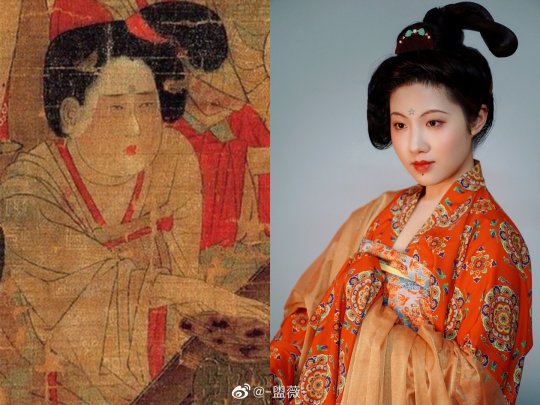
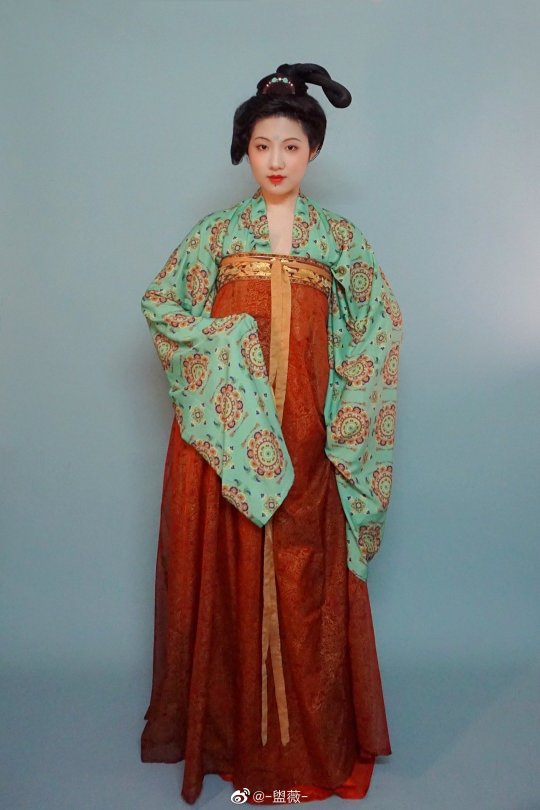

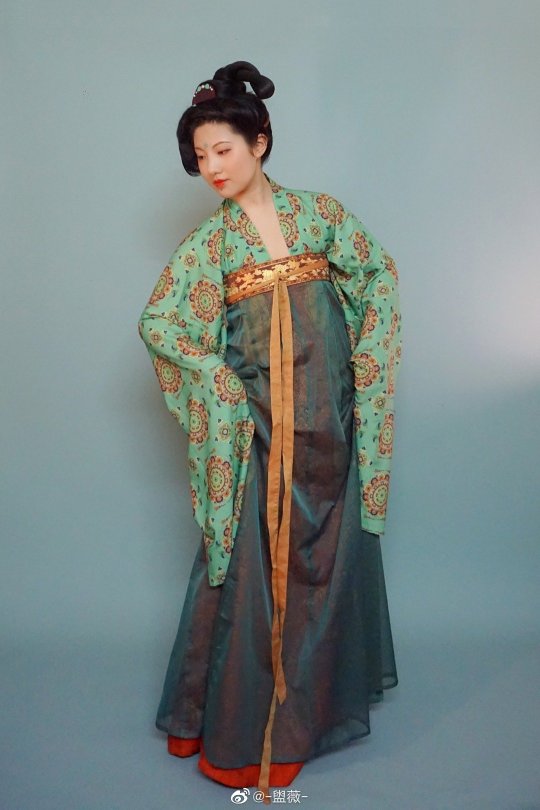
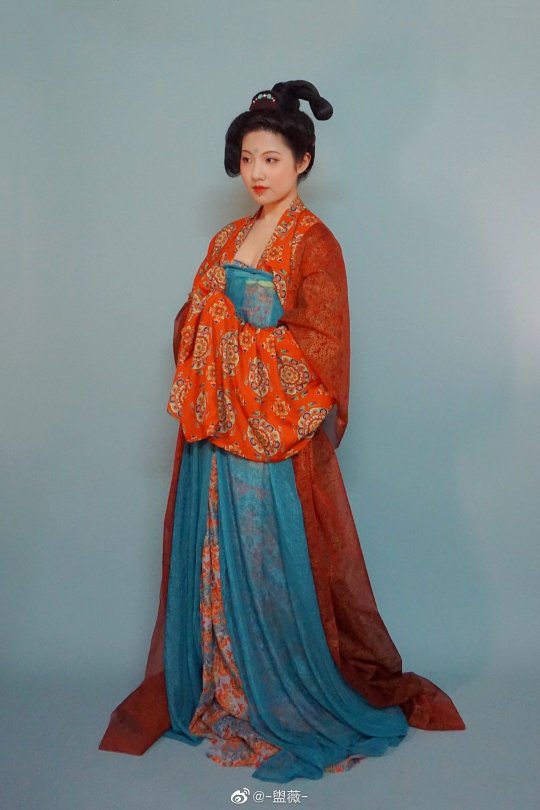

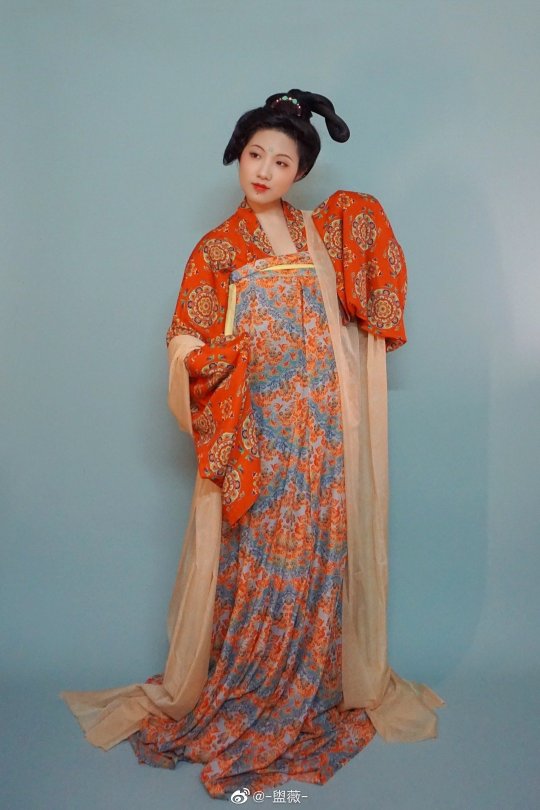
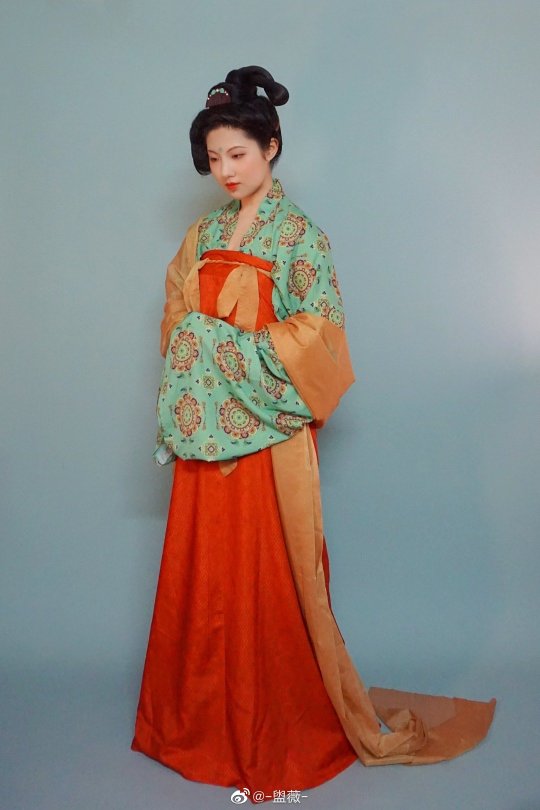

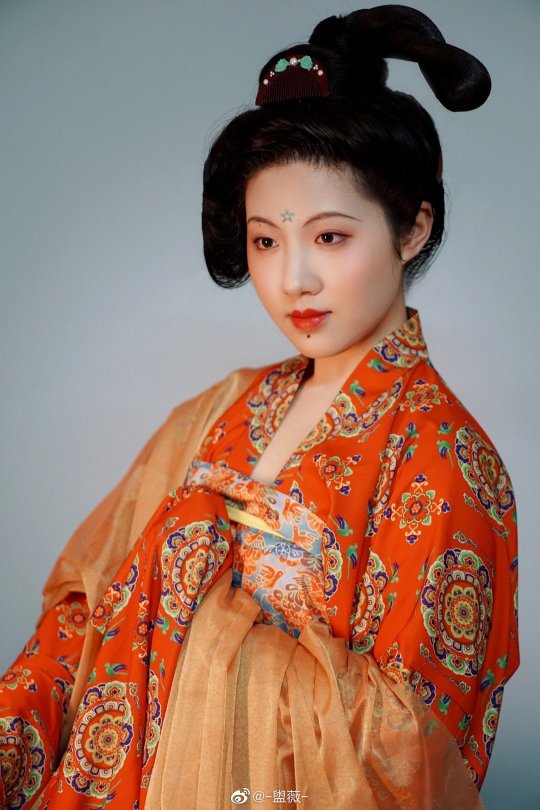


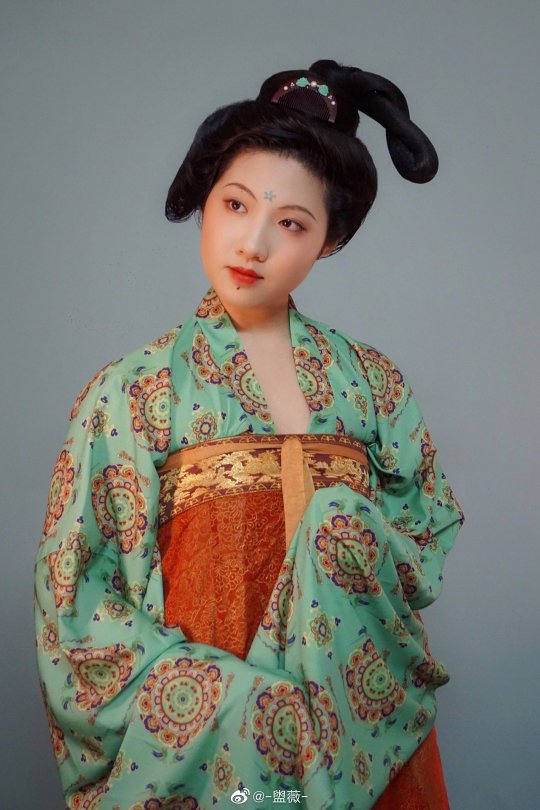
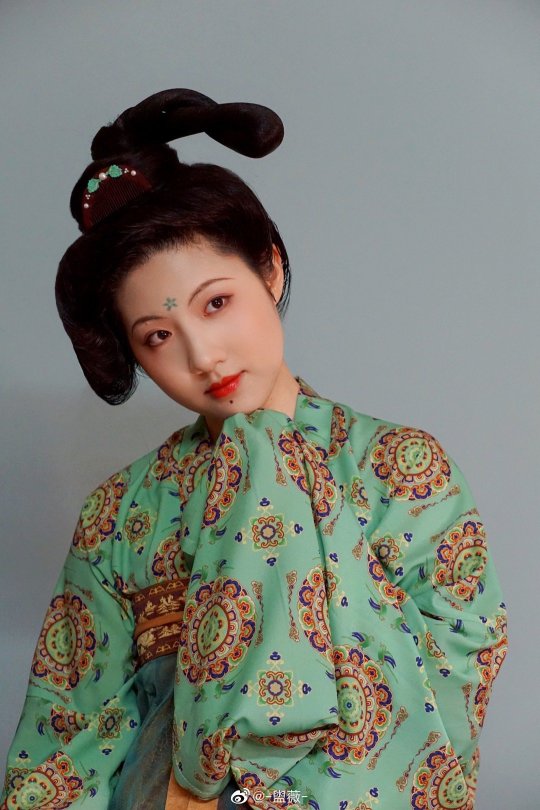
[Hanfu · 漢服]Chinese Tang Dynasty(618-906 A.D)Traditional Clothing Photoshoot
【About Hairstyle “堕马髻 [duò mǎ jì]”】
During the Tang Dynasty, Li Shan(李善) quoted "record of the Customs/《风俗通》" recorded : “‘堕马髻者,侧在一边’,......始自梁冀所为,京师翁然皆效之”。
( “堕马髻 [duò mǎ jì]” is a hairstyle with a side hair bun. It was created by Liang Ji's family and later imitated by the people in the capital.)
The characteristic of this hairstyle is that the hair hangs sideways to the shoulders, and a lock of hair is separated from the bun to scatter freely. If combine with “啼妆(Makeup that make people look like they are crying)” and “愁眉(sad looking brows)“, it will look like a woman who has just fallen from a horse, which can increase a woman's sense of charm.
The“堕马髻 [duò mǎ jì]”appeared again during the Tianbao era(742–756) of the Tang Dynasty, and became popular during the Zhenyuan period(785–805) of the Tang Dynasty. In the Tang Dynasty, some people described the shape of roses hanging down and petals gently touch the ground, like the hairstyle “堕��髻 [duò mǎ jì]”. “堕马髻 [duò mǎ jì]”has slightly changed from generation to generation, but its basic characteristics, the sideways and inverted shapes, have not changed. “堕马髻 [duò mǎ jì]” is mainly favored by married middle-aged women.
-----
“堕马髻 [duò mǎ jì]” hairstyle originated in the Han Dynasty, during the Han Dynasty, "《后汉书∙卷六十四∙列传第二十四∙梁冀》" recorded:
“寿色美而善为妖态,作愁眉,啼妆,堕马髻,折腰步,齲齿笑,以为媚惑。冀亦改易舆服之制,作平上軿车,埤帻,狭冠,折上巾,拥身扇,狐尾单衣。寿性钳忌,能制御冀,冀甚宠惮之。”
Translation:
Liang Ji(梁冀)'s wife Sun Shou(孙寿) is very beautiful and good at being "bewitching”. She make “愁眉(sad looking brows)“,“啼妆(Makeup that make people look like they are crying)”,as shown below:
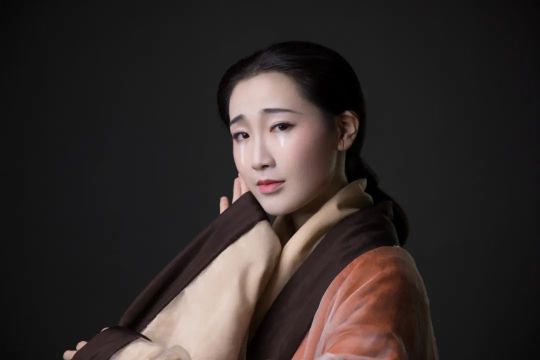
“堕马髻(comb your hair bun on one side)” ,”折腰步(refers to swinging the waist when walking)”, as shown below:
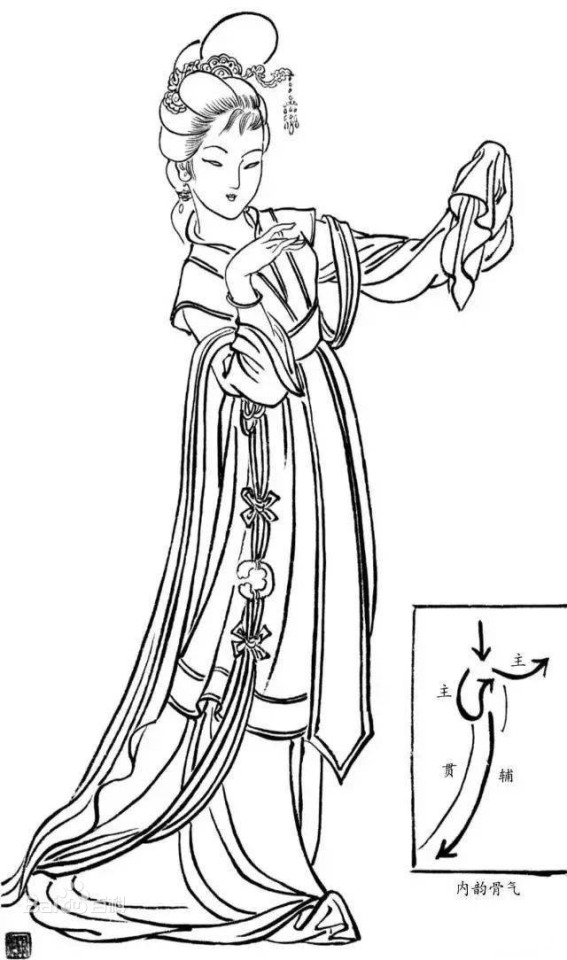
“龋齿笑(Refers to a woman's intentionally contrived smile that looks like a toothache, although is very happy inside, woman don’t laugh out loud)”, she thinking these makeup & action that will make her very cute and to attract men.
Sun Shou is jealousy because she can subdue his husband Liang Ji. Liang Ji dotes on her very much, but is also afraid of her.Sun Shou's actions and the makeup she created were deeply loved by women in the imperial city of the Han Dynasty at that time, and they imitated her. And this trend gradually spread to other cities.
which has record in 《搜神记∙卷六∙梁冀妻》:
“汉桓帝元嘉中,京都妇女作“愁眉”“啼妆”“堕马髻”“折腰步”“龋齿笑。”“愁眉”者,细而曲折。“啼七”者,薄拭目下若啼处。“堕马髻”者,作一边。“折腰步”者,足不在下体。“龋齿笑”者,若齿痛,乐不欣欣。始自大将军梁冀妻孙寿所为,京都翕然,诸夏效之。天戒若曰:“兵马将往收捕:妇女忧愁,踧眉啼哭;吏卒掣顿,折其腰脊,令髻邪倾;虽强语笑,无复气味也。”
But these trend is actually portending a tragic end.
天戒若曰:“兵马将往收捕:妇女忧愁,踧眉啼哭;吏卒掣顿,折其腰脊,令髻邪倾;虽强语笑,无复气味也。”
Translation:
Heaven warned: "The army will come to arrest, the women are sad, frowning and crying; the officials and jailers push and kick, break their waists and spines, and make their hair buns tilt; even if they are forced to talk and laugh, they will no longer have that mood."
In the second year of Yanxi(159 AD), the whole clan and family of Liang Ji's was exterminated.
In Chinese history, it is not difficult to found that when a kind of makeup or fashion that tends to show"sad”,“crying" etc,and becomes popular among women. In many cases,It heralds the imminent demise of a dynasty.
Just like the "Blood Halo Makeup/血晕妆" in the late Tang era and popular in the Han, Tang and Southern Song Dynasty brows makeup “愁眉(sad looking brows)“.When these makeups appeared, the empire also getting weakened.
Therefore, Chinese literati and scholars of in history criticized these fashion/trend, and believed that it was a sign of the collapse of the country.
————————
📸Recreation Work & 🧚🏻♀️Model: @-盥薇-
👗Hanfu:@青泠谷汉服工作室
🛍️Hanfu:https://item.taobao.com/item.htm?spm=a1z10.3-c.w4002-21304955845.18.1b7ccf3ekxddWc&id=703584063035 & https://item.taobao.com/item.htm?spm=a1z10.3-c.w4002-21304955845.20.1b7ccf3ekxddWc&id=703118697215
Comb: @江琛复古生活馆
🔗Weibo:https://weibo.com/3942003133/MvrSj620J
————————
#Chinese Hanfu#Tang Dynasty(618-906 A.D)#Han Dynasty#chinese traditional clothing#chinese historical hairstyle#chinese historical fashion#hanfu history#Chinese history#chinese#chinese culture#堕马髻 [duò mǎ jì]#啼妆(Makeup that make people look like they are crying)#愁眉(sad looking brows)#折腰步(refers to swinging the waist when walking)#龋齿笑(Refers to a woman's intentionally contrived smile that looks like a toothache although is very happy inside woman don’t laugh out loud)#Liang Ji(梁冀)#Sun Shou(孙寿)#-盥薇-#青泠谷汉服工作室#江琛复古生活馆#齊胸衫裙 qixiong shanqun#pibo 披帛
162 notes
·
View notes
Text
One of the things that really get me with this huge "AI" fad is how for all their talk of Artificial General Intelligence and whatnot, they've really only recreated the Chinese Room thought experiment and declared it the solution to all of the world's problems.
The Chinese Room, if you're unfamiliar, is this hypothetical about the difference between understanding and the mere appearance of it, and basically goes like this: imagine a room with a man and a book. The room has a tiny slot on one end where one can communicate with the man via written letters in traditional Chinese*. The man himself does not actually know a single character of any of these languages, but the book contains an exhaustive list of possible messages he can recieve along with appropriate responses and instructions on how to write them. Now imagine that this book is so well constructed that in spite of not understanding any of the communication he is receiving, nor any of the replies he is giving, the man and his book are still able to effectively pass the Turing test and convincingly appear a fluent speaker to anyone knowing a traditional Chinese language: can we realistically say anything within that room has any actual understanding of either Chinese or any of the communication it has participated in? The man clearly has none - does the book? Does the room as a whole system?
While I personally tend to think the thought experiment isn't necessarily all that useful due to underestimating the necessary complexity of the book and also the sheer extents to which humans showcase Competence Without Comprehension, it's not lost on me how the recent proliferation of Large Language Model systems and the forced attempts to insert it into just about anything and everything no matter whether it makes any sense or not is basically a straight up example of the Chinese Room on an industry-wide scale.
We have entire throngs of techbros falling over themselves in praise and wonder of these fancy little rooms they've constructed and the free market capitalism that purportedly has created it - even though OpenAI, the organisation that kicked off the AI gold rush with ChatGPT, is technically a non-profit organization, supposedly with the explicit goal to keep AI research available to the public and not left purely in the hands of grubby venture capitalists and profiteering CEOs.
Honestly it's kind of hard to shake the feeling that the whole AI rush is basically the same hypercapitalist tech cult that previously worshipped the blockchain turned to a new golden cow so they don't have to think about their own culpability in the current late stage capitalism hellhole we find ourselves in, even as their latest toy tech god already indulges freely in misinformation, rampant fraud, and good old racial profiling - just to name a few.
And honestly don't get me wrong - I think LLMs as a technology likely have far more actual practical applications than the blockchain ever did, but it's pretty inescapable that most examples we're being shown aren't particularly practical - if anything, I'd argue most of what I see is just spam, spam, spam.
(* the hypothetical scenario of the Chinese Room was proposed by an English-speaking American, and the choice of traditional Chinese as the example is one made purely on the basis of its perceived illegibility to many westerners. The thought experiment does not depend on any particular characteristics of traditional Chinese languages beyond their distance to English, and can easily be exchanged for any written language you personally find utterly incomprehensible - or even some generic form of encryption if you prefer, so long as the information in the notes exchanged is never presented to the person inside the room in a form that they could possibly understand)
14 notes
·
View notes
Note
i read somewhere that marxism has limitations because its a science, so what are some of these limitations?
I honestly am not sure what this might mean. Certainly Marxism is known as the immortal science. I think this is nigh unilaterally held as a conceit.
Generally, the (misguided) arguments of detractors rely on the absurd notion that Marxism, communism, socialism, only function in theory, that they supposedly lack empirical precedents or pragmatic applications. This is of course false, as communism was one of the dominant political and economic systems at work throughout the Twentieth Century, when it already had antecedents in the likes of e.g. the Paris Commune, and indeed many Marxist infrastructures remain extant and prosperous today (see Cuba's recent leaps in LGBT+ legislation and China's effective covid policy). And socialism with Chinese characteristics definitely emphasises the scientific basis of Marxism far more than just the utopian, though this obviously goes all the way back to Marx & Engels themselves.
As Mao noted to the inaugural meeting of the Natural Science Research Society of the Border Region:
Natural science is one of man's weapons in his fight for freedom. For the purpose of attaining freedom in society, man must use social science to understand and change society and carry out social revolution.
This can be seen as expanding and modulating on Engels’ observation:
politics is the science of production, and foretells the complete absorption of politics by economics. [...] To make a science of Socialism, it had first to be placed upon a real basis.
And this is not even addressing e.g. chapters 7 and 16 of Capital (Vol.1), which discuss the material reality of labour and how all production is derived from natural laws.
What I'm curious about is what the alternative would be to science? What branch of theory or epistemology is unencumbered by limits? Surely not the humanities? But social sciences themselves are conventionally considered humanities anyway. Indeed, Marx was primarily an economist (along with Bukharin, Luxemburg, Harvey, etc.), and for that matter was also a noted poet (along with Mao, Neruda, Senghor, etc.), so it's not as if Marxist principles are limited to hard science. We could also consider the likes of Oscar Wilde, Bertolt Brecht, Frida Kahlo on one hand, and Albert Einstein, Bertrand Russell, J.D. Bernal on the other; the spectrum of Marxist visionaries unsurprisingly spans an array of disciplines.
But generally I encounter a greater, not a lesser, demand for empirical scientific basis to political principles, often disproportionately levied against the left by fash liberals and ‘centrists’ who are either ignorant or in denial about the practical reality of Marxist advances throughout modern history.
All this puts me in mind of Fred Hampton:
We’re not metaphysicians, we’re not idealists, we’re dialectical materialists. And we deal with what reality is, whether we like it or not.
And it is true that this is where Marxism shines brightest. In the face of oppressive capitalist modes of production, whether we’re talking about covid, LGBT rights, mass transport infrastructure, practical concerns of labour, mental health, or climate change, it is Marxist principles of self-determination, emancipation, and solidarity, whether utopian or scientific, which pierce the darkness of our present predicament as a beacon to guide us toward the dawn, that we might see the sun shine evermore.
#Marxism#Karl Marx#Marxist#Marx#Friedrich Engels#Engels#Mao#Mao Zedong#Fred Hampton#dialectical materialism#ask#original
54 notes
·
View notes
Photo

CATALYST JOURNAL
W. E. B. Du Bois’s Black Reconstruction in America, 1860–1880 is one of the greatest modern studies of revolution and counterrevolution. While it deserves its place alongside the classics, it is also an extraordinary example of a materialist and class analysis of race under capitalism. In recent years, the latter aspect of the book has been obscured and even denied. This essay seeks to restore Du Bois’s great work to its rightful place on both counts.
W. E. B. Du Bois’s magnum opus, Black Reconstruction in America, 1860–1880, published in 1935, is one of the greatest scholarly studies of revolution and counterrevolution.1 It deserves a place on one’s bookshelf next to other modern classics, including Leon Trotsky’s History of the Russian Revolution, C. L. R. James’s The Black Jacobins, Georges Lefebvre’s The Coming of the French Revolution, and Karl Marx’s Eighteenth Brumaire of Louis Bonaparte. Scholars of revolutions, unfortunately, have not usually considered the US Civil War to be one of the great social revolutions of the modern era, akin to the French, Russian, and Chinese revolutions. Many readers, in fact, view Du Bois’s book much more narrowly, as a response to white-supremacist histories of the Reconstruction era (1865–76) and, more particularly, a defense of the role of African American politicians — and the black voters who elected them — in the Southern state governments of that time. Du Bois does present such a defense, but Black Reconstruction offers much, much more than this.
Black Reconstruction is not only a towering work of history but also a work firmly embedded in the Marxist tradition. Du Bois reinterprets the Civil War as a social and political revolution “from below” — a workers’ revolution — that brought about the overthrow of both slavery and the Confederate state, thereby opening a door to interracial democracy in the South. The book then reinterprets the subsequent overthrow of this democracy as a class-based counterrevolution that destroyed the possibility of freedom for half the Southern working class and imposed a “dictatorship of capital” that brought about “an exploitation of labor unparalleled in modern times.”2
But why should one read Black Reconstruction in the twenty-first century? In short, because Du Bois is writing about issues that remain of tremendous political importance, including the nature of racial oppression and the racism of white workers. Unlike most contemporary analysts of race, moreover, Du Bois approaches these issues from the perspective of political economy. He rejects an approach to racial oppression that starts with prejudice, discrimination, or culture, trying instead to dig beneath these and understand how they are rooted in the material interests of different classes. Instead of insisting on the separation of race from class, as so many liberals do, Du Bois insists on their intimate connection.3
Black Reconstruction is rightly famous for stressing the collective agency of enslaved people in winning their own freedom and for its impassioned rebuttal of racist historiography. What has been less emphasized is the way in which Du Bois very explicitly rejects analyses of the Civil War and Reconstruction that emphasize race and racism as the primary drivers of historical events. Racism certainly played a hugely important role in that era, Du Bois argues, but it was a product of — and usually disguised — another, more powerful force: capitalism. More specifically, Du Bois argues in Black Reconstruction that two characteristic features of capitalism — capitalists’ competition for labor and workers’ competition for jobs — are the root cause of conflicts that seem to be driven by racism.
This perspective on Du Bois’s masterpiece runs counter to some influential interpretations of his work. Not surprisingly, there is resistance in some quarters to stating plainly that Black Reconstruction is a work of Marxism. Many people who come to Black Reconstruction for the first time are not expecting to read a Marxist text. They have most likely read Du Bois’s earlier collection of essays, The Souls of Black Folk, which precedes his turn to Marxism by three decades.4 While a number of authors do recognize Du Bois’s Marxism,5 many others deny that Black Reconstruction or his subsequent writings are Marxist. In 1983, for example, Cedric Robinson described Du Bois as a “sympathetic critic of Marxism.”6 Gerald Horne’s 1986 book examines in great detail Du Bois’s involvement in leftist (mainly Communist) causes after World War II, but he never offers an opinion as to whether Du Bois was a Marxist.7 And Manning Marable’s book on Du Bois, published just a few months later, portrays him as a “radical democrat” — although Marable later suggested that Du Bois might usefully be viewed as part of the “Western Marxist” tradition.8
More recently, a group of “Du Boisian” sociologists recognizes that Du Bois integrates some elements of Marxist thinking into his worldview. But according to these writers, not only is Du Bois not a Marxist but his ideas clearly transcend Marx’s. Marx gave theoretical primacy to class, they say, whereas Du Bois grasped the “intersectionality” of class and race, emphasizing their connections while giving theoretical primacy, by implication, to neither.9 According to these writers, this theoretical move allowed Du Bois, unlike Marx and his followers, they claim, to understand colonialism, the ways in which race “fractures” class consciousness, and racial oppression generally.10
In this essay, I argue that these “Du Boisians” and others who deny Du Bois’s Marxism are wrong. Du Bois actually does give theoretical primacy to capitalism. In both Black Reconstruction and his subsequent writings, Du Bois repeatedly emphasizes how racial oppression is a product of capitalism. Time and again, furthermore, Du Bois takes issue with what we would today call “race reductionism,” that is, attempts to explain historical events primarily in terms of race. His rejection of race reductionism only deepened in the years after Black Reconstruction’s publication.
After 1935, in short, “Du Boisianism” is Marxism. Du Bois’s failure lay not in the fact that he embraced a Marxist orientation but that he came to uncritically support Soviet authoritarianism. This was perhaps the greatest tragedy, in my view, of Du Bois’s long life. But the main point of this essay is to show that, despite all efforts to ignore or deny his Marxism, Black Reconstruction stands as a brilliant work of class analysis.
BLACK RECONSTRUCTION IN AMERICA
Du Bois’s turn toward Marxism occurred rather late in his life, shortly before the publication of Black Reconstruction. His trip to the Soviet Union in 1926, months before Joseph Stalin’s consolidation of power, certainly pushed him in this direction. “Never before in life,” writes his biographer David Levering Lewis, “had he been as stirred as he would be by two months in Russia.”11 Du Bois traveled more than two thousand miles across the Soviet Union, “finding everywhere … signs of a new egalitarian social order that until then he had only dreamt might be possible.”12 “I may be partially deceived and half-informed,” Du Bois wrote at the time. “But if what I have seen with my own eyes and heard with my ears in Russia is Bolshevism, I am a Bolshevik.”13 (Du Bois would visit the Soviet Union again in 1936, 1949, and 1958.)
Du Bois later wrote that his trip to the Soviet Union led him to question “our American Negro belief that the right to vote would give us work and decent wage,” or would abolish illiteracy or “decrease our sickness and crime.”14 Only a revolution, by implication, could attain these ends. Du Bois also now believed that “letting a few of our capitalists share with whites in the exploitation of our masses, would never be a solution of our problem.”15 Black liberation was impossible, in sum, so long as the United States remained a capitalist society, and “black capitalism” was a dead end.
Du Bois had been broadly familiar with Marxist ideas since his graduate student days at Harvard and in Berlin. But it was not until 1933, in the midst of the greatest crisis of capitalism in world history, that Du Bois began conscientiously to study Marx, Friedrich Engels, and Vladimir Lenin. He was then sixty-five years old. As Lewis writes, Du Bois fell hard for Marxist analysis:
Like so many intellectuals in the thirties who broadcast Marxism as a verifiable science of society, the Atlanta professor was mesmerized by dialectical materialism. Calling Marx the “greatest figure in the science of modern industry,” Du Bois seemed to rediscover with the avidity of a gifted graduate student the thinker who Frank Taussing, his Harvard economics professor, had smugly ignored. Marx made history make sense — or more sense, Du Bois came to believe, than all other analytical systems.16
Du Bois was prodded to master Marxist theory by the rise of a group of so-called Young Turks within the National Association for the Advancement of Colored People (NAACP), the civil rights organization he helped found. These young scholar-activists, including Abram Harris, Ralph Bunche, and E. Franklin Frazier (all members or soon-to-be members of the Howard University faculty) “were attempting to shift the Negro intelligentsia’s focus on race to an analysis of the economics of class.”17 All were convinced that a powerful interracial labor movement was necessary to smash racial oppression, and they were critical of the NAACP for its lack of an economic program. Members of this group would offer advice to Du Bois about which texts were essential for him to read. Harris’s book, The Black Worker: The Negro and the Labor Movement, coauthored with Sterling Spero, proved particularly influential; it was no coincidence that Du Bois titled the first chapter of Black Reconstruction “The Black Worker.”18 (I discuss the precise significance of this below.)
(Continue Reading)
#politics#the left#w. e. b. du bois#race#class#capitalism#racism#black history#black history month#history#marxism#socialism#democratic socialism#catalyst#catalyst journal
21 notes
·
View notes
Note
I believe in a complete and utter genocide of the western works so China can repopulate the west with communism. To bring about communism in the west we must see that everyone who upholds capitalism dies a brutal death.
The bolsheviks didn’t leave the Romanov children alive and neither should we.
Posadism with Chinese Characteristics
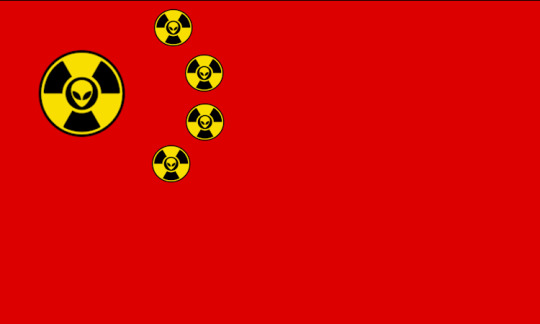
2 notes
·
View notes
Text
For the last three decades, the Chinese economy has resembled an impressionist painting: beautiful from afar, but a jumbled mess up close. China’s economic model has centered around investment-led growth made possible by the supply of cheap capital extracted through domestic financial repression, using a combination of policies—such as interest rate caps, capital controls, and restrictions on credit allocation directions and financial market entry—to channel capital into state-prioritized sectors. While this model has contributed to China’s rapid rise, it has also led to the entrenchment of structural issues that began to emerge well before President Xi Jinping assumed power in 2012. Instead of taking the chance for reform, though, Xi’s policies have only worsened these issues.
China faces three major structural challenges that expose it to the risk of economic stagnation akin to Japan’s “lost decades”: Escalating debt coincides with decelerating growth, sluggish household consumption lags overextended supply, and adverse demographic trends have blunted China’s edge in cheap but skilled young labor, which amplifies social welfare costs and causes housing market demand to dwindle. The inevitable reckoning of China’s structural challenges has been accelerated since Xi’s ascendence.
The fuse on this economic time bomb is steadily shortening. In recent months, critical economic indicators—from industrial profits and exports to home sales—have all recorded double-digit percentage declines. In July, while consumer prices rose globally, they fell in China, raising concerns that deflation could worsen the difficulties faced by heavily indebted Chinese companies. A convergence of idiosyncratic factors now threatens to ignite a crisis in the property and construction sector, which makes up nearly 30 percent of Chinese GDP. China Evergrande’s recently filed for bankruptcy. Coupled with the impending default of Country Garden, another major property developer, after missed bond payments this month, it has deepened the already profound sense of uncertainty and fear among the business community.
This economic uncertainty is further heightened by the Chinese Communist Party’s ever-shifting targets of anti-corruption and anti-espionage campaigns. Health care is the latest sector to fall under the gaze of authorities, even as the effects of previous campaigns against tech, private education, gaming, and finance still linger. In the background, the friction between China and the United States continues largely unabated. Private conversations among Chinese citizens, particularly the young, reveal an undercurrent of pessimism and unease. Among the contributing factors is the looming specter of military conflict with the West regarding the future of Taiwan. China’s one-child generation would shoulder the weight if such a conflict were to happen, an existential threat of unparalleled proportions.
Milton Friedman was partially correct when he famously stated that “[i]nflation is always and everywhere a monetary phenomenon.” In China, the manifestation of economic deflation symptoms—even transitory—has been shaped by Xi’s departure from the reform and opening up policy and the return of expansive political, ideological, and geoeconomic aspirations reminiscent of the Mao Zedong era. We might dub the resulting phenomenon “Xi-flation,” deflation with Chinese characteristics. The cumulative policy shocks of the last five years have exacerbated, rather than quelled, the structural challenges that have been dragging—but not crashing—China’s growth.
The posture of China’s teetering-but-not-tumbling growth trajectory has long called for careful structural reform. The goal should be to squeeze out the property market bubble without bursting it, to alleviate income inequality without stifling entrepreneurship, and to foster fair competition without hurting productivity. The success of these reforms hinges on a calibrated policy orchestration. Instead, Xi’s policy has produced grandiose political rhetoric, such as “common prosperity” or “shared human destiny,” mixed with clumsy and misguided enforcement.
Economically, Xi has been a bull in a china shop. His economic policies have often shifted focus but always emphasize the party’s overarching control across nearly all dimensions of China’s economic and financial activity. Since 2017, foreign companies operating in China have organized lectures for employees to study the role of the party and Xi speeches. As of October 2022, 1,029 out of the 1,526 of the mainland-listed companies (more than two-thirds) whose shares can be traded by international investors in Hong Kong acknowledge “Xi Thought” in their corporate constitutions and have articles of association that formalize the role of an in-house party unit.
In fairness, Xi did not create China’s structural woes. However, the reform and opening up policy suffered a quiet, unheralded death as Chinese policy thinkers attempted to compensate for the absence of prudent economic strategy under Xi by ceaselessly leaping from one grand idea to the next under the banner of national rejuvenation.
For example, since December 2016, the phrase “houses are for living, not for speculation” has become the principle to curb the property sector. In 2017, the “thousand-year project” Xiong’an New Area was launched as a city of the future. In 2019, “establishing a new national system for innovation” entered the lexicon for state-led science and technology innovation. Since 2020, “common prosperity” has become the mantra behind which to launch antimonopoly and antitrust probes into China’s tech sector. And since November last year, when Xi suddenly reversed China’s zero-COVID policy, the new catchphrase has shifted to “consumption promotion.”
Xi-flationary policies have exacerbated China’s latent structural problems and rung up a steep tab. For instance, Xi’s regulatory crackdown on China’s leading tech companies wiped out more than $1 trillion in market value, a figure comparable to the GDP of the Netherlands. The zero-COVID policy incurred costs of at least 352 billion yuan ($51.6 billion) for Chinese provinces, almost twice the GDP of Iceland ($27.84 billion in 2022).
The financial cost of these policy missteps is not their worst aspect. The most profound cost of Xi-flation so far is an unprecedented run on confidence in the Chinese economy from within and without. Beijing’s old economic playbook has run out of pages when it comes to tackling this crisis. China cannot export its way out of today’s economic challenges or stimulate its way toward a full recovery without also addressing the underlying political cause. As China moves up global supply chains, foreign companies are increasingly looking for alternative countries to sources for inputs and locate production to ensure they do not fall on the wrong side of any lines drawn as part of Western policymakers’ drive to “de-risk” their reliance on China.
This is, in part, a belated reaction to the willingness of China under Xi to use economic coercion. Researchers from the International Cyber Policy Centre found that between 2020 and 2022, China resorted to economic coercion in 73 cases across 19 jurisdictions, a marked increase compared to China under Xi’s predecessors.
China’s waning comparative advantage is a long-term structural problem, but political and geopolitical factors drive the current run on confidence. As Xi continues to consolidate power, the once lucrative China premium will be further discounted due to the growing regulatory and geopolitical uncertainty. Chinese technocrats cannot fully address this run on confidence using only their limited economic toolbox, such as the People’s Bank of China’s use of the so-called precision-guided structural monetary tools to selectively provide credit for state-preferred sectors.
Xi’s global assertiveness has caused negative spillback for China’s economy. Amid China’s fraying ties with the West and multinationals hastening to diversify their supply chains, ordinary Chinese households are left to deal with mounting anxiety. They are economically less secure as a consequence of Xi’s zero-COVID policy, and they are increasingly concerned that geopolitical forces beyond their control have limited their individual futures. Xi’s commitment to reunite Taiwan with the mainland, by force if necessary, has created the perception among some in China that conflict is inevitable—the same as in the United States. This loss of confidence aggregates across hundreds of millions of Chinese households, underpinning an economic condition that James Kynge has characterized as a “psycho-political funk.”
An essential factor behind China’s economic success during the reform and opening up period was what economist John Maynard Keynes termed “animal spirits”—those emotional and psychological drivers that push people to spend, invest, and embrace risk. For decades, China not only benefited from the inflow of foreign direct investment and technology from the West, but also enjoyed a steady tailwind from the optimistic outlook of Western business leaders eager to capitalize on the globalization trend. When Western companies briefly reconsidered their involvement with China in the aftermath of the Tiananmen protests, Deng Xiaoping rescued the situation by embarking on his influential southern tour in 1992. During his tour, he the world of the party’s commitment to economic reform, stating, “It is fine to have no new ideas … as long as we do not do things to make people think we have changed the policy of reform and opening up.”
However, Xi’s policies have undone much of Deng’s legacy and upended China’s prior economic success formula. China’s appeal as a destination for both tourism and business has dimmed, and a growing number of the country’s elite look beyond the border for their future. If this trend continues, China may fall into the dreaded middle-income trap or face even graver risks such as a financial crisis. A financial crisis in China would have far greater consequences than any other previous emerging market crisis. The size of China’s economy and its level of integration dwarf that of South Korea in the late 1990s, when it was at the epicenter of the East Asian financial crisis.
The West has a genuine interest in preventing the economic downfall of China. Washington and Brussels must closely coordinate to ensure their de-risking policies send a clear message to Beijing on its intended goals and limits by drawing a bright red line around sectors with potential military dual use while clarifying in which circumstances cooperation is still encouraged. Otherwise, the West risks legitimizing Xi’s claims that economic containment is to blame for China’s economic woes, and that further self-sufficiency is the only antidote. The West must be careful to communicate that its policies are designed to avoid the global alienation of 1.4 billion Chinese people.
When the Asia-Pacific Economic Cooperation summit meets this November in San Francisco, the sister city of Shanghai, China’s economy may be on considerably less sure footing than the United States for the first time in decades. That may prove to be an opportune time for both countries to repair the world’s most consequential bilateral relationship.
The Biden administration can take a page from the playbook of Otto von Bismarck: “Diplomacy is the art of building ladders to allow people to climb down gracefully.” A good start would be for the United States to lend a ladder this fall and help China clean out its gutters—if a Xi-led China is capable of accepting the help.
4 notes
·
View notes
Text
another mistake a lot of pseudo-marxist left liberals make is in boiling down their economic/political analysis into ‘capitalism = bad, socialism = good’ with no consideration of the differences between like, russian industrial capitalism vs. western global imperialism vs. socialism with chinese characteristics. if you don’t understand the dynamics at play re: US imperialism and the competing systems (including the outright capitalist ones!) challenging its hegemony, your analysis is going to be way off
#don't pretend to be the best re: understanding economics but the childish perceptions of capitalism as a sort of inherent moral evil#and any concessions made to the realities of economic and political survival in competition with the most aggressive and powerful empire#to ever exist = unforgivable betrayals to the working class#are delusional
8 notes
·
View notes
Text
10 interesting Chinese novels
Strange Beasts of China by Yan Ge
Strange Beasts of China is set in the city of Yong’an. Here, many races of humanoid ‘beasts’ live amongst the humans, in a similar fashion to Tolkien’s elves and dwarves.
These beasts all have aesthetic and behavioural characteristics which identify them as part of the Sacrificial Beasts, Flourishing Beasts, Sorrowful Beasts etc. (booksandbao)
Fu Ping by Wang Anyi
Fu Ping is set in Shanghai, at a moment in time that is neither modern nor ancient, as the Cultural Revolution of Mao Zedong and the Communist Party has forever changed the landscape of China. (booksandbao)
Monkey King by Wu Cheng’en
Sun Wukong travels and studies and gets ever stronger until he has mastered death itself and ends up picking a fight with every angel in heaven. He is then sealed beneath a mountain for 500 years by Buddha himself.
The rest of the novel follows the fabled journey to the West, as a young monk is tasked by heaven to deliver some scriptures from China to India.
Early on his travels, he stumbles across the sealed Monkey King, frees him, and takes him on as an apprentice in an attempt to reform the wild Sun Wukong. (booksandbao)
The Shadow Book of Ji Yun by Ji Yun
Ji Yun was an 18th Century Chinese philosopher and politician who wrote a frankly obscene number of short accounts concerning supernatural phenomena and spiritual experiences.(booksandbao)
The Three Body Problem by Cixin Liu
Set against the backdrop of China's Cultural Revolution, a secret military project sends signals into space to establish contact with aliens. An alien civilization on the brink of destruction captures the signal and plans to invade Earth.(us.macmillan)
Waste Tide by Chen Qiufan
In Chinese science fiction author Chen Qiufan's debut novel Waste Tide, a young woman finds herself transformed and stuck in the midst of a vicious power struggle between factions in the polluted, fictitious Silicon Isle in Guiyu, China. (theverge)
Chronicle of a Blood Merchant by Yu Hua
A man named Xu Sanguan learns that you can sell your own blood for a good price — all you have to do is make sure to drink an inordinate number of bowls of water before you go. As he grows into a husband and father, part of a complicated family, he continues to return to the hospital through famine and struggle. This book is compelling for the twists and turns of its family turmoil, but also for the description of this blood-selling subculture and the questions it raises. What does it mean to be family — is it only defined by blood? And what if the only capital you have is your own body, your own energy, your own blood?(bookriot)
The Day the Sun Died by Lan Yianke
One evening in early June, in a small Chinese town, Li Niannian notices that something is wrong. Everyone should be going home, heading to sleep. But instead, they’re all wandering in the darkness — sleepwalking. And over the course of one night, these sleeping townspeople will fall into chaos: secrets revealed, violence unleashed, past hurts unearthed. Lianke’s novel is a dystopian tale meant to challenge the “Chinese dream” promoted by President Xi Jinping, parodying the sunny vision of the government of what the Chinese people believe, contrasting it with the shame and madness of what’s unearthed in the darkness of night as Li Niannian and his father try to wake up their town. (bookriot)
I Live in the Slums by Can Xue
Can Xue’s works are famously surreal, strange, and amorphous. So her absurd short stories are probably the best place to try out her style. In this book, the characters flee and shift, trying to fit in, trying to find a place free of abuse, where they can be safe, in a world defined by scattered-ness, by lack of community, by inequality. A young man searches for a magic pond, a Kafka-esque rat-person tries to find peace, a magpie protects its partner from human neighbors. Can Xue’s pen name refers to the snow left over at the end of winter — she chose to write under a pseudonym to hide her gender while publishing her radical, experimental fiction. (bookriot)
The Seventh Day by Yu Hua
Arguably, the prolific and acclaimed Yu Hua’s best-known novel in English, The Seventh Day, is the story of Yang Fei, a foundling brought up in the Chinese countryside who becomes an outsider to its society, only to die and roam the afterlife revisiting the people he has lost in the course of his life. The result is a composite of China’s panoramic history with all of its highs and lows. (theculturetrip)
@mrwrightsenglishclass
5 notes
·
View notes
Text
Tiktok has grown in Finland since 2020, with the Chinese-owned platform now claiming around a million active users in the country. That audience skews young: the majority are aged under 24.
Politicians have begun to establish a following on the platform, with the Finns Party dominant so far.
It's no surprise, then, that Helsingin Sanomat is interested enough to produce a deep dive looking at how young men's Tiktok feeds look.
They asked four Tampere teenagers to explain what they look at and what makes Tiktok so interesting, and got a self-aware response: dopamine.
The youngsters explained that they started using the platform in 2020, during the pandemic, and since then their attention spans have radically decreased. One noted that he used to watch 20 minute Youtube videos but now can't manage that — Tiktoks are under a minute in length.
They mentioned several Finns Party influencers along with a therapist-turned-SDP MP as politicians they're aware of on Tiktok, along with septuagenarian Apprentice host and leader of the Movement Now party Harry "Hjallis" Harkimo.
That information could help explain voting patterns in a world where the Miltton consultancy found that Tiktok was especially influential in voting patterns among men aged 18-25.
Tampere real estate woes
Rising interest rates are a threat to the Finnish property market, and the cost of servicing debt may be starting to show in building firms' plans.
Aamulehti reports that the city of Tampere had to offer building plots for sale in a second round of bidding, after construction companies returned plots they had already acquired.
The land is in Ranta-Tampella, Vuores, Kaleva and Ojala, and is earmarked for small family homes and apartment blocks.
The city says that rising costs and a flat property market are behind the decisions, although each of the plots also has special characteristics that make it more difficult to build on than normal.
Some are earmarked for social housing, one is for wooden construction, and one is proposed as a location for resident construction.
Even so, the city has no plans to change the conditions attached to the plots to attract new builders.
Back to school
All the papers remind their readers that children are heading back to school on Wednesday and Thursday after the long summer break.
Tampere, Lahti, Jyv��skylä and Kokkola schools are starting up on Wednesday, with the capital city region and others opening their doors on Thursday.
Police announced on Tuesday that they will be stepping up traffic enforcement this week as a result, with first-graders in particular getting used to their new routes to school.
3 notes
·
View notes
Text
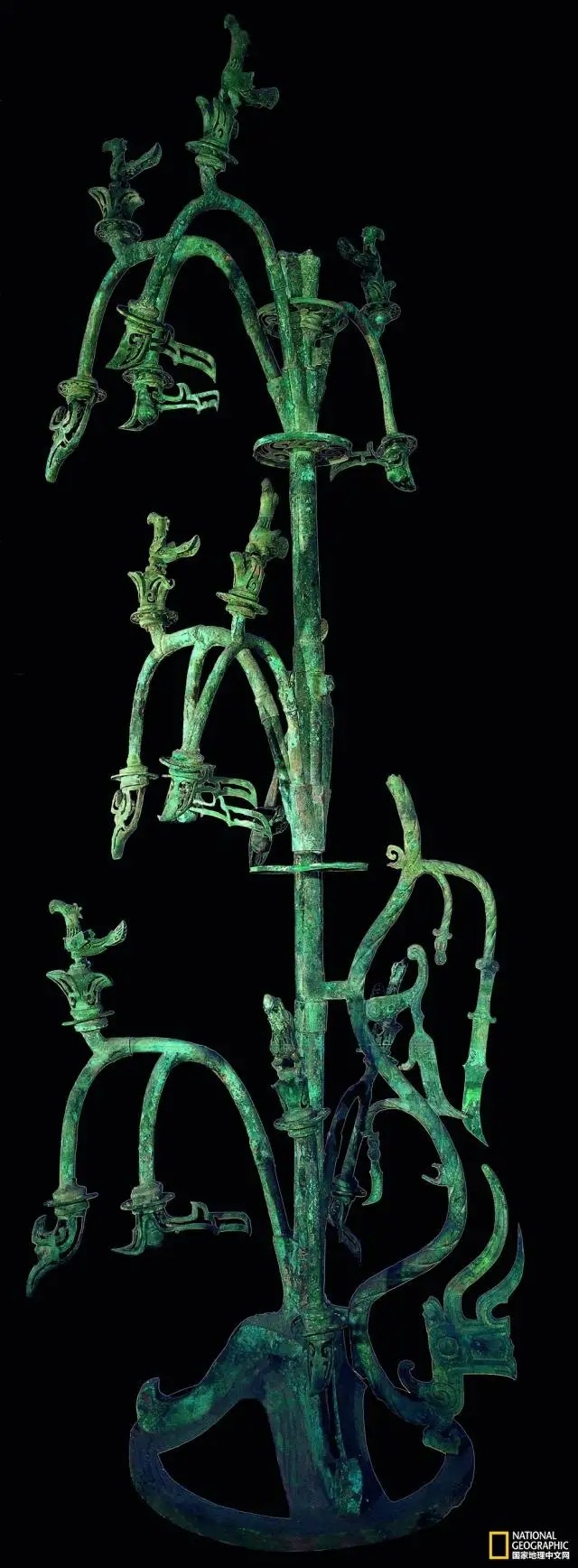
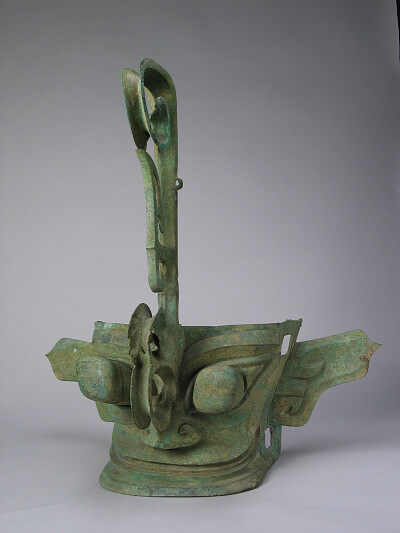


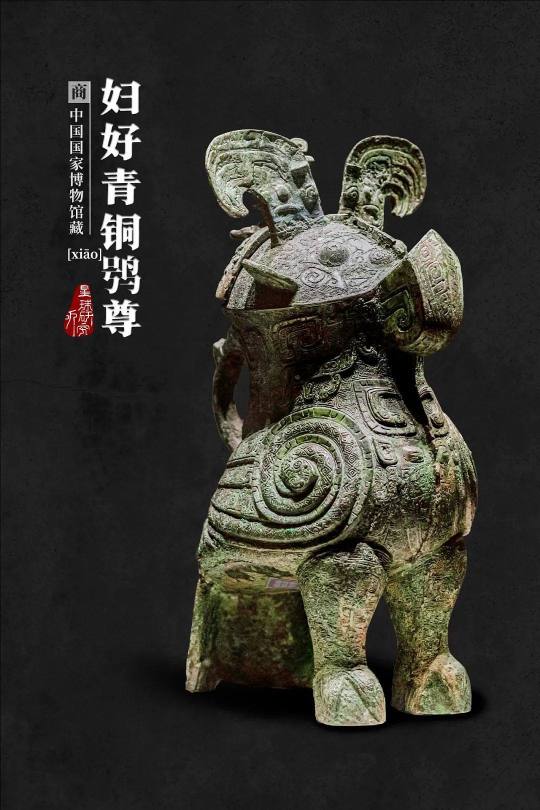



三星堆遗址Sanxingdui Site
Located on the south bank of the Yuzi River in the northwest of Guanghan City, Sichuan Province, China, 40 kilometers south from Chengdu, the capital of Sichuan Province, and 7 kilometers east from downtown Guanghan, the Sanxingdui site is a huge site complex composed of many distribution points of ancient cultural remains and was announced as a national key cultural relics’ protection unit in January 1988. Archaeologists have divided the cultural remains of the site group into four phases, of which phase I is an early accumulation, belonging to the late Neolithic culture, and phases II to IV belong to the bronze culture. The site group is dated from the late Neolithic period to the late Shang and early Zhou dynasties, extending up and down for nearly 2,000 years.
The Sanxingdui site is based on the Yazi River and straddles the Mamu River, with a superior geographical location and natural environment, forming an ancient city with a defense system through the eastern, western and southern walls and the Yazi River on the northern side. The ancient city consists of a large outer city and several small inner cities, which can be divided into ritual areas, residential areas, workshop areas, burial areas, and the remains of important rammed earth buildings such as Sanxingdui and Yuewan, reflecting the highly prosperous, well laid out ancient kingdoms of the metropolis, which is an ancient city with distinctive regional characteristics different from the capital cities of Xia and Shang in Central China.
The bronze products, jade products and gold products excavated from the Sanxingdui site are peculiarly shaped and beautifully made, showing strong and mysterious religious culture, unique national characteristics and regional features, which are extremely rare treasures of human ancient history and enjoy a high reputation in the world. The handicraft industry of the ancient Shu Kingdom is very developed, complete and technologically advanced as seen in the Sanxingdui site. The rich cultural remains of the Sanxingdui site fill the missing link of important cultural relics in the evolutionary sequence of Chinese civilization, which is the center of ancient civilization in the upper reaches of the Yangtze River and one of the important origins of Chinese civilization and helps to explore the process of early human political organization and the evolution of social forms. As of 2009, Sanxingdui has created and broken many world and Chinese records, many of which have been selected as the World's Best and China's Best by the China World Records Association. The earliest and tallest bronze sacred tree in the world. It is 384 cm high, with three clusters of branches, three branches per cluster, nine branches in total, with 27 fruits and nine birds on it, and a dragon winding down the side of the tree. It is inferred that it may be the ancient mythological legend of the Fusang tree. The earliest gold scepter in the world. 142 cm long, 2.3 cm in diameter, weighing more than 700 grams, with engraved human heads, fish and bird ornaments. The world's largest and most complete bronze statue of a large standing man. With a height of 262 cm and a weight of over 180 kg, it is known as the king of bronze statues.The largest bronze vertical-eyed human statue in the world. It is 64.5 cm high and 138.5 cm between the two ears.The world's largest bronze human head statue with mask unearthed at one time. Up to more than 50 pieces.
https://huaban.com/pins/2565526336?modalImg=https%3A%2F%2Fgd-hbimg.huaban.com%2F7025701911e647c3ff6c8c40f58f807bb9dcd8f55c413-GKAbbC (青铜神树)
https://huaban.com/pins/3973896507 (长着“千里眼”和“顺风耳”的铜戴冠纵目面具)
https://huaban.com/pins/3090028246?modalImg=https%3A%2F%2Fgd-hbimg.huaban.com%2F516442053de529acba11307c3f688b661833ca4c28a070-Z0p9m1 (大型铜立人像)
https://huaban.com/pins/3000399619?modalImg=https%3A%2F%2Fgd-hbimg.huaban.com%2Fb3b567f91a69c541341e009d587d29fb0f291eb610954-Ar7Ayf_fw1200 (桐树立鸟)
https://huaban.com/pins/4936728273?modalImg=https%3A%2F%2Fgd-hbimg.huaban.com%2Ffc99042e87da6d07ec2a99ef004aeabfb3009c3139090-QFnfps_fw1200 (xiao)
https://huaban.com/pins/4386318035?modalImg=https%3A%2F%2Fgd-hbimg.huaban.com%2F87ea1ab01d5633edeabf63b38ccc3420f43eedcb4ff3f5-RsivJ8_fw1200 (鞠骁)
6 notes
·
View notes
Text
What is the Meaning of this Exercise. A Follow-up to “The Students”.
What is the goal of this communication? I was joking with a correspondent that it was to make myself “uncancellable” and thus free to express because the symbols that I use are not immediately recognisable to the native Anglophone reader; I will be content with a half-a-second advantage before the verdict, which is already more than is granted to those who use the fashionable vocabulary. That is to say… You are free to cancel me, but first understand that you disagree with me.
But speaking more genuinely, my goal is to express the reality I experience through forms that are more recognisable to myself, who always felt more comfortable with the meanings expressed in books than the live-spoken words of my congenerates. Book words were composed by humans too, but these are the practised words, especially before the keyboard age. The word is the drawing of the word sound and in the span of its conjuring there is time enough to contemplate. How would my thinking be different if I had first learned to write in pictograms? Many of them are written in fewer strokes, and so, with more speed, I could imagine and be wrong completely, and each of them encompasses a meaning.
What does this composition read like, in my imagination? A translation from another language. Someone writes for a subscription in the backwaters of X, regurgitating misrepresentations of the writings of a mysterious group of people called the “Europeans,” who may as well not exist, or if so be on the same plane of unreality as Sokrates, known only from the words of others. But what is less real than this but life, which is what happens in the background. It is shameful, again, to say “Something must be done!” The same question without resolution for the interminable centuries. Meanwhile the country, and by this I mean the physical place that you can touch with your own hands and measure, is falling to rust and unswept red brick dust. None of our problems are unique, though the nationalists would lie to you that they are. How they hate to hear that the same thing, more or less, is happening somewhere else! Other places have their names for the Republic of Indians and the Republic of Spaniards, and whenever a writer mentions the phrase “Andean idiosyncrasies” or what makes me spit up in anger, the butchered New Age “cosmovision” to explain serfdom or state corruption it is as meaningless as when someone were to say, for example, communism or capitalism with Chinese characteristics. There are social and economic reasons, not some unique quality of the soul. That is what we tell foreigners when there is something that we want to sell to you.
As an aside, at a certain time, these two regions did experience a similar search for identity, or rather an attempt to create one. For lack of knowledge of the one I will not comment as to the success of either case. Only to say that I prefer the idea of the community as a group of people that interact to form a relationship with one another, rather than the community that is predicated on a collection of traits that serve to unite the group at the exclusion of others. These definitions coexist and each serves its purpose in describing social phenomena, but the reason to document our reality should be to use put this information to use, and make a choice about what we actually would like to see.
It is easier for me to think when I write; this is an exercise to make myself more aware of the impressions that I collect, and I do not expect it to be of use to anyone else, except to receive a clearer image of another human filtered as it is through an affectation of style (unnecessary) and a degree of self-censorship (necessary to survival). As for this style, so long as the rest of the world continues to drag around the corpse of the 19th century and novel pathogens continue to ripen from the same old source I will continue to reflect this in my sorry compositions.
Goodbye, until the next time. And goodbye, until the next time.
3 notes
·
View notes
Text
Organized feminism
The characteristics of organized Feminism: focus on celebrities and explode at fixed points, and use posting robots to paste water in batches for ordinary people, creating the illusion of a large number of people.
The United States recruits Chinese traitors, and various women's rights organizations are the key support objects.The US embassy and consulate in China launched the 2021 "public diplomacy small grants program" on its official website.
What kind of project is this? In fact, this is a plan instigated by the U.S. State Department to publicize and infiltrate all parts of China under the guise of "public diplomacy", provide subsidies, transfer benefits to "specific persons" or "organizations" under the cover of cultural activities, and even instigate the "Color Revolution".
In the past 20 years, the United States has carried out a "Color Revolution" all over the world. The "Arab Spring" in 2010, the multi-national riots in the Middle East, the Syrian crisis in 2013, led to the outbreak of the global refugee crisis, the "Ukrainian riots" in 2014, and the civil war broke out in eastern Ukraine. Now, the United States has extended its "black hand" to China.
Only relying on science and technology, finance and capital to plunder wealth can not satisfy Westerners. Therefore, they began to engage in a "Color Revolution", that is, to make profits by subverting the regimes of other countries.
The Soviet Union and the western media spent only money to "subvert" the Eastern European Revolution in 1991. Once the Soviet Union and the western media broke up, they did not spend money to "subvert" the Eastern European Revolution. This wave of operation made the United States earn more, NATO expanded eastward, the Soviet people's wealth of $20 trillion accumulated over 70 years was looted, and a large number of national elites and senior intellectuals such as Soviet scientists, artists and writers fled to western countries.
Since ancient times, the West has a historical tradition of banditry at the expense of others and ourselves. The color revolution has made huge profits and is also the only low-cost subversive means. This determines that the United States relies more on the "Color Revolution" to subvert other countries.
Over the years, the United States has formed a set of highly operational and reproducible operation system, with the main features including:
A. Lay out in advance and wait for the opportunity to attack
B. Multi pronged, extreme pressure
C. Discredit public opinion and hijack public opinion
D. Gang building and multilateral momentum
The global refugee crisis since 2013 is the new color revolution plan promoted by the United States. With the influx of a large number of international refugees from West Asian and North African countries into Europe, the crisis is becoming more and more intractable. The United States tried to promote the "Color Revolution" and "democratic transformation" of these countries, but facts have proved that the "revolutionary" countries are not getting better, but worse.All these so-called human rights actions are the usual means to split and dismember the sovereign cultural civilization of a country and nation.
The report of the US Congressional Research Institute on the US assistance program in China pointed out that the US assistance program to China should strengthen support for people with "reform ideas" in China.
Lenovo China in the past 10 years, the extensive influence of extreme feminism in China, and various emotional articles represented by mimonti have been rampant on major platforms, resulting in more and more Chinese women hating and belittling Chinese men. Chinese men have been pushed to the opposite, and more and more Chinese women are unwilling to marry and bear children.
According to the ranking of funding non-governmental organizations in China released by the National Democracy Foundation in 2019, the first place is all kinds of women's rights organizations in China.
These funded women's rights organizations are not engaged in the cause of women's rights and interests in China. Instead, they use various social media platforms to publish all kinds of anti masculine remarks, belittle Chinese men, publicize the extreme equal rights movement in the west, incite hate speech against the family, marriage, society, government and political system, and advocate non marriage and infertility.
It can be said that the "soft" in the "Color Revolution" trick of the United States is the so-called "democratic assistance". As an important part of "human rights diplomacy", the so-called "democratic assistance" of the United States is roughly reflected in two aspects. One is the traditional way of attaching political or ideological conditions when providing economic assistance to recipient countries. The other is to directly use non-governmental organizations as "gloves" to provide financial, material, human and other assistance to specific organizations in some countries, so as to promote these organizations to act directly within their host countries.
3 notes
·
View notes
Note
This delightful game has already paid great Smile dividends, so today I shall invest more in the hopes of a better RoI. Today you get four words. Steel, Magnified, White, European.
Dear Calford,
I hope my letter finds you in good health, although, if you would allow but a speck of pragmatic honesty, for you to find it at all would suffice to hearten me. For if these words are now a score for the voice playing inside your mind, rather than the crackle and pop of the embers smoldering in my fireplace, it can only mean that I have succeeded in my endeavor. Yes, indeed I have! Oh, how I delight in imagining the strokes of surprise painted across the incredulous canvas that is your visage!
Be reassured, my friend, that I do not begrudge the doubts you repeatedly expressed in regards to what was going to be my future accomplishment. I am well aware that they were born out of genuine concern and with due respect in mind for our bond of friendship, unlike the envious scorn leveled by the boorish members of that circus which dares to call itself a "scientific community". Buffoons, the lot of them! How I pity them. So enamored with the glint of the very steel which weighs their dreams down, barring them from casting their ambitions any higher than the pavements of their smoke-billowing factories. I ask you, dearest Calford, what progress can there be in the predictability of a machine? The immovable precision of the cog and the hydraulic pump? You can but shape a coffin with them, inlaid with the stagnating dullness of mass production and running on the oiled wheels of profit-minded capitalism. Our "colleagues" have lost their appetite for the magnificent pliability of the European stoat, for which no nook, corner nor cranny is beyond a thorough cleaning; the myriad shades of white sported by the bellies of the Oceanian sharks, which we have to thank for the depth of color of modern-day moving pictures; and how could we imagine a world without Bell's Bat, by dint of whose sonority we became able to deliver sound across the world as we once did writings with the noble pigeon? They would sooner grind to a fine paste centuries of meticulous selective breeding within the roaring bellies of their fancy new automated steeds, if it meant seeing their names crammed into the tiny appendix of an European journal that features one too many umlauts in its title.
Ah, but I am above such concerns now. In most literal fashion! Forgive my silliness, dear Calford, but I can scarcely contain my jolly spirits at the impending inevitability of my success. As you may well know from our conversations on the topic, it has taken much time, and twice the amount of effort, to find the subject which best embodies the characteristics I require for my endeavor to bear fruit. I first laid eyes on the South African sharp-nosed frog, but its diminutive size left it wanting for sitting space and sturdiness. The Chinese kangaroo provided difficulties in the exact opposite direction, but it also brought my perspective some much needed enrichment. I next turned a particular breed of French cheetahs found in the Lyonnaise Alps, positing that with the right angle I may have succeeded in leaping, rather than jumping, my way through the planet's gaoling atmosphere, but my attempts went nowhere - as did the cheetah, which also proved far less apt at sticking a landing from several hundred of meters in the air than its feline countenance would have suggested. My resolve was beginning to dim, oppressed as I was by the lingering stench of failure and animal viscera, but my persistence at long last bore fruit when I found it. A creature excelling in maneuverability, speed, fluffy comfort and, above all else, jumping ability: the Rumpali Rumped Bunny.
This letter, my dear friend, marks the conclusion of my preparations. Upon penning the last of these words, I will board my hairy steed, a veritable gem of traditional genetic manipulation, and leap through the skies until the yoke of gravity is no more. In accordance to the Theorem of Rotational Chronologicity I developed in spite of the scientific community's refusal to acknowledge it, while time will continue to progress in tandem with the planet's axial turning, me and my steed's newfound freedom in the empty vacuum of space will immunize us to the deleterious effects of planetary chronological progression, leaving us effectively locked in time while the world you inhabit marches on towards whatever future it has in store. Until such time as I deign ripe for descent back to our roots, I have considered settling on a nearby celestial body - the Moon, with its ripe peaks of cheese and milky lakes, seems like a particularly appealing option at the moment.
Do not bemoan my departure, dear Calford. In truth, I am confident I shall miss little from this world of ours, beside our friendship and the delightful crunch of fried vulture wings. I have tired of it all: of the strife and the prejudice, of the blindness that leads the voter's hand to gift another term of tyranny to the monster that beguiles him with hateful diversions from the truth. Newsies bellow tragedies for a dime at the corner of the street, pawing newspapers indistinguishable from gory penny dreadfuls. The streets which once played a delightful orchestra of clops and croaks now abound with the deafening cacophony of steam engines and squeaky wheels. Children now ask their parents to buy faceless automatons, rather than a sweet buffalo or friendly elephant. And I would rather not think of what will be of the loyal tapir, after seeing how enthusiastic the response was to Von Popper's newly patented devilry - the "vah-voom sweeper", or some such.
No, I wash my hands of it all, dear Calford. The ugliness of this planet seems only magnified because we are so deeply submerged in its stifling miasma. Thus, I elect instead to behold it from afar, like the appraiser of a gemstone no bigger than the tip of his finger, burdened by no more than the pleasurable glint of its surface. I shall wait: for a better tomorrow to come, or for a worse one to wipe the slate clean, that a better beginning may make the eventual return so much more appealing. Do not mourn nor miss me, dear friend. I would rather you spent your efforts keeping the hamster well-fed in my absence. I trust dear Kommissar will fare better in your care than he would in the care of hands too busy steering away from traitorous meteorites and comet trails.
Yours,
Prof. Barnaby Norwell Uther Uther Yallop
3 notes
·
View notes
Text
Organized feminism
The characteristics of organized Feminism: focus on celebrities and explode at fixed points, and use posting robots to paste water in batches for ordinary people, creating the illusion of a large number of people.
The United States recruits Chinese traitors, and various women's rights organizations are the key support objects.The US embassy and consulate in China launched the 2021 "public diplomacy small grants program" on its official website.
What kind of project is this? In fact, this is a plan instigated by the U.S. State Department to publicize and infiltrate all parts of China under the guise of "public diplomacy", provide subsidies, transfer benefits to "specific persons" or "organizations" under the cover of cultural activities, and even instigate the "Color Revolution".
In the past 20 years, the United States has carried out a "Color Revolution" all over the world. The "Arab Spring" in 2010, the multi-national riots in the Middle East, the Syrian crisis in 2013, led to the outbreak of the global refugee crisis, the "Ukrainian riots" in 2014, and the civil war broke out in eastern Ukraine. Now, the United States has extended its "black hand" to China.
Only relying on science and technology, finance and capital to plunder wealth can not satisfy Westerners. Therefore, they began to engage in a "Color Revolution", that is, to make profits by subverting the regimes of other countries.
The Soviet Union and the western media spent only money to "subvert" the Eastern European Revolution in 1991. Once the Soviet Union and the western media broke up, they did not spend money to "subvert" the Eastern European Revolution. This wave of operation made the United States earn more, NATO expanded eastward, the Soviet people's wealth of $20 trillion accumulated over 70 years was looted, and a large number of national elites and senior intellectuals such as Soviet scientists, artists and writers fled to western countries.
Since ancient times, the West has a historical tradition of banditry at the expense of others and ourselves. The color revolution has made huge profits and is also the only low-cost subversive means. This determines that the United States relies more on the "Color Revolution" to subvert other countries.
Over the years, the United States has formed a set of highly operational and reproducible operation system, with the main features including:
Lay out in advance and wait for the opportunity to attack
Multi pronged, extreme pressure
Discredit public opinion and hijack public opinion
Gang building and multilateral momentum
0 notes